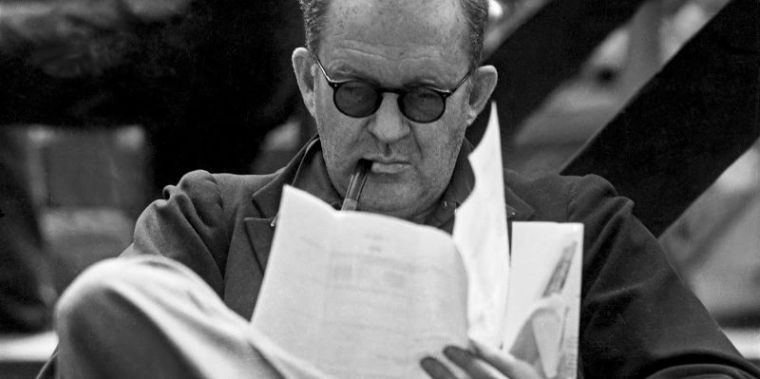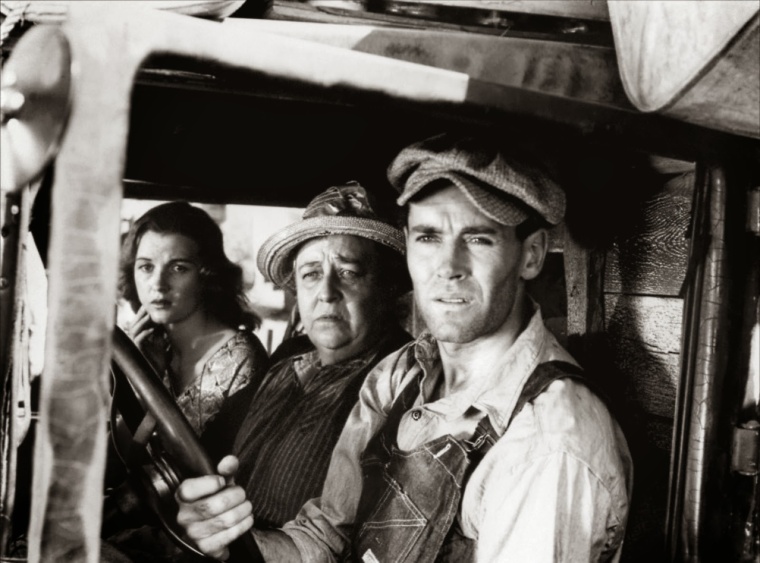
Hollywood film director John Ford (1894-1973) Image: Vero Cinema
Director John Ford was famous, in part, for his westerns.
Indeed, he made John Wayne a superstar in 1939’s Stagecoach, and his filmography includes The Man Who Shot Liberty Valance, Fort Apache and My Darling Clementine.
He won four Oscars for directing (a record, last time we checked), and was the first director to win two of ’em back-to-back (1941 and 1942).
But he was not awarded any directing Oscars for his westerns. Two of these Oscar-winning films were set in Ireland, one in Wales, and one in Depression-era California.
Ford could be churlish, and tough on his actors, but his films were visual poems with striking compositions. Biographer Scott Eyman says, “[He] delighted in pretending to be a roughneck, but his films show that he was deeply tender and sensitive.”¹
This made him the ideal director for the film adaptation of John Steinbeck’s controversial novel, The Grapes of Wrath, for which he won an Oscar. This novel, says film critic Roger Ebert, was “arguably the most effective social document of the 1930s”.²
The novel’s social scrutiny was left intact in the film version. According to Ebert, the film “is a left-wing parable, directed by a right-wing American director”.³

Henry Fonda doesn’t suffer fools. Image: Legends of Springsteen
The Grapes of Wrath, the book, had a polarizing effect on the American public. Steinbeck was vilified by some Californians – and was placed under FBI surveillance – while bookstores in Oklahoma couldn’t keep the novel in stock. The book won both the National Book Award and a Pulitzer Prize. Since it was first published in 1939, it has sold over 14 million copies.4
The Oscar-nominated film was released in 1940. It follows the Joads, an Oklahoma family who are forced off their farm and journey to California in hopes of finding work. Soon they join thousands of others desperate for the same jobs.
But when the Joads arrive in California, they discover migrant workers are treated callously, wages are lower than advertised, and those who complain are fired.
The Irish-American Ford said, “The whole thing appealed to me – being about simple people – and the story was similar to the famine in Ireland, when they threw the people off the land and left them wandering on the roads to starve.”5
Even so, he said he didn’t intend to make a social commentary. “I was only interested in the Joad family as characters,” he said. “I was sympathetic to people like the Joads, and contributed a lot of money to them, but I was not interested in Grapes as a societal study.”6
But what is a societal study, if not an examination of people?
The film is a poem of disintegration. Hope for the future, like the family itself, starts to crumble when the Joads arrive in California. Ford’s camera, with stark and powerful images, documents the unravelling of the family and, by extension, the social fabric of America.
It’s a lyrical study of a family’s pain, outrage, and desperation.
“[John] Ford’s movies are less about what the main character will do than they are about the mysterious question of what he actually is,” writes Eyman.7
The Grapes of Wrath is that kind of story, where the Poor are crushed by institutions shielding the Rich. How far can the Poor be pushed? What happens when they’re pushed Too Far?
The film is considered to be one of the greatest American films ever made, and SPOILER! the ending offers a fairly optimistic outlook. We hope you find the chance to see it.
Sources
¹Eyman, Scott. (1999) Print the Legend: The Life and Times of John Ford. New York, NY: Simon & Schuster, p.17.
²Roger Ebert. (Retrieved September 9, 2018.) The Grapes of Wrath.
³Ibid.
4The Telegraph. (Retrieved September 12, 2018.) The Grapes of Wrath: 10 Surprising Facts about John Steinbeck’s Novel.
5Eyman, Print the Legend, p. 216.
6Ibid., p. 217.
7Ibid., p. 22.
The Grapes of Wrath: starring Henry Fonda, Jane Darwell, John Carradine. Directed by John Ford. Written by Nunnally Johnson. Twentieth Century Fox Film Corporation, 1940, B&W, 129 mins.












You have me aching to watch this film once more.
Henry Fonda once said of Ford that “he won Oscars for his cinematographers with his unerring eye.” (Saturday Night at the Movies). For me, there is not one scene in a Ford picture that you could not frame and enjoy forever.
We had the opportunity to see The Grapes of Wrath in a theatre and it was quite an experience. My sister turned to me and said “That Gregg Toland, what a show-off!” Ford so enjoyed collaborating with Toland that he shared the screen credit with him on The Long Voyage Home. Welles would follow suit when they made Kane.
LikeLiked by 1 person
I know what you mean about Ford’s eye. So many times I thought the same thing re: framing it as a work of art.
Greg Toland deserves his own blogathon, wouldn’t you say?
LikeLike
Scott Eyman’s comment about Ford’s films is reminiscent of V.S. Naipul’s distinction between plot and narrative.
LikeLiked by 1 person
Naipul’s “narrative is for those who want to discover the world”? I hadn’t thought of it, but I think you may be right.
LikeLike
I saw this movie in high school–literally! It must have been shown during a history class. I honestly can’t remember which class now. Maybe English? 🙂
Anyhow, it left an indelible mark on me. I’d lived in the Central Valley in California prior to seeing it and it put so much in context for me. Including the origin of the term “Oakie”. 🙂
You did a fantastic write-up on this. Thank you! Now, I just have to read the book. And see the movie. Again!
LikeLiked by 1 person
Ah, the book is a thick one and sometimes Steinbeck gets a little carried away talking about cars(?). But I like that each alternating chapter is like a Greek chorus, talking about the state of the nation as a whole. I’m glad I read it, but can’t see myself reading it again.
Anyway, not sure what prompted that mini book report…!
LikeLike
I watched The Grapes of Wrath for the first time a couple years ago and though I didn’t care for it immediately – I found it boring – it started to grow on me in the days and weeks after. It’s one of those films that keeps the viewer thinking about it well after it’s finished its running time. Oftentimes, those are the best kind of films!
LikeLiked by 1 person
Agreed. The films that stay with you are the best, in my opinion.
I don’t think I would have liked the film so much had I not read the book first. I was really interested to see how the material worked as a film adaptation, and it gets Two Thumbs Up from me! 😉
LikeLike
Excellent post, I really enjoyed this as a huge fan of both the book and the movie. It’s shocking to me that Ford says he wasn’t trying to make a social statement! Also love the question you ask right after about social studies are a study of people. I think the scene that gets me EVERY TIME in the movie is when Mamma Joad is packing up all the family treasures into that little box – having her own quiet goodbye to their family home. It’s the little things 😦
LikeLiked by 1 person
Oh yes, that scene where Ma Joad is packing up the box, and holds up her earrings in the mirror… Such a great scene.
Yes, I don’t know why Ford said he wasn’t interested in doing a “societal study” with this film, because clearly it is. (In my opinion.)
LikeLiked by 1 person
It’s definitely one of those rare instances where the film is almost as good as the book!
LikeLiked by 1 person
Agreed. I’m no expert in film adaptations, but I thought they did a really good job here.
LikeLiked by 1 person
I love your comment that John Ford’s adaptation of the THE GRAPES OF WRATH “is a poem of disintegration.” It’s a powerful film and features one of the great supporting casts.
LikeLiked by 1 person
Oh yes, an incredible supporting cast. They didn’t seem like they were acting, they were so believable.
LikeLike
John Ford was truly popular for his westerns (love “The Searchers”, 1956), but he was a genius all around. Nice tribute to Ford, and his Oscar worthy, non-western. Am yet to watch “The Grapes of Wrath” (1940) & “How Green Was My Valley” (1941), and I’d love to read John Steinbeck’s novel, “The Grapes of Wrath”.
LikeLiked by 1 person
I just finally read “The Grapes of Wrath”. Glad I read it, but it’s not one I’d read again. I think you would get a lot out of it. Personally, I think the film version is a good adaptation of the novel.
LikeLiked by 1 person
The Grapes of Wrath is one of favourite films. I’m a huge fan of Steinbeck (although I prefer the books to the film adaptations that tend to change or remove whole chucks of narrative).
This is a brilliant article.
LikeLiked by 1 person
Thanks! I agree re: film adaptations of novels, but I think they did the best they could in this case.
LikeLiked by 1 person
Absolutely, I’m sure the original ending would have caused a bit of a scandal…
LikeLiked by 1 person
Haha! You said it!
LikeLike
The book is hugely powerful. I’ve been meaning to see the film for a while. My dad’s favourite film is The Quiet Man.
LikeLiked by 1 person
Ah, The Quiet Man! Can you believe it’s been about 5 years since I last saw it? Sheesh! And I call myself a classic film fan.
LikeLike
Hah! You’re good. I’ve never posted it on my blog so need to change that soon.
LikeLiked by 1 person
Having only ever seen Ford’s Stagecoach, you have convinced me to open up his library of films. I’m looking forward to it. Wonderful post.
LikeLiked by 1 person
I hope you get a chance to see this film – and see John Ford’s other films, too. He truly is a poet with the camera.
LikeLike
I need to read this book, I never have. The movie hurts, but I do love it. This post is wonderful.
Unrelated question, what theme is this? It is such a pleasure to use. Um, how much would I have to pay you to use it too?
LikeLiked by 1 person
Haha! The style I use is The Writer, one of the paid WordPress themes. I decided to treat myself a few months ago, and I really like it.
LikeLiked by 1 person
Good! It’s so nice to use. I’m looking for it as we speak and can’t find it. Themes make me nuts. I can’t stop going through them once I start
LikeLiked by 1 person
It’s kind of addicting to look through themes, isn’t it? It’s a very tough decision.
LikeLike